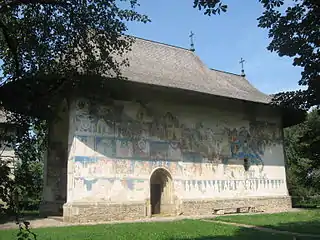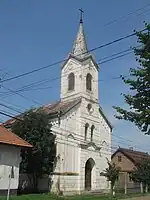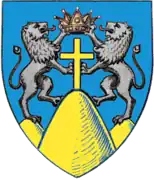Arbore
German: Deutsch-Arbora | |
|---|---|
 | |
 Coat of arms | |
 Location in Suceava County | |
 Arbore Location in Romania | |
| Coordinates: 47°44′N 25°56′E / 47.733°N 25.933°E | |
| Country | Romania |
| County | Suceava |
| Government | |
| • Mayor (2020–2024) | Dan Tiperciuc (PSD) |
| Area | 66.1 km2 (25.5 sq mi) |
| Elevation | 369 m (1,211 ft) |
| Population (2021-12-01)[1] | 6,887 |
| • Density | 100/km2 (270/sq mi) |
| Time zone | EET/EEST (UTC+2/+3) |
| Postal code | 727015 |
| Vehicle reg. | SV |
| Website | primariarbore |
Arbore (German: Deutsch-Arbora) is a commune located in Suceava County, Bukovina, northeastern Romania. It is composed of three villages: namely Arbore, Bodnăreni, and Clit.
The commune is located in the central-north part of the county, 37 km (23 mi) northwest of the county seat, Suceava. It lies on the banks of the river Solca, whose tributary, the Saca, flows into the Solca in Arbore.
Church of Arbore
Arbore is best known for its church, dedicated to Saint John the Baptist. Its painted church was the first painted church to be included on the UNESCO World Heritage List of the Churches of Moldavia.
The monastery and the commune are named after the boyar Luca Arbore who built the church in 1503. The construction of the church was completed in about 5 months. Its exterior paintings date from 1541 and were made by Dragoș Coman. Painting the church took about 40 years.
Conservation state of outside paintings
The outside paintings on the western wall are the most well preserved, as opposed to those on the northern facade, which suffered extensive weather-related damage. This damage arose mostly because the church roof was plundered by marauding Cossack troops and melted in order to make bullets (the original roof was made of lead).
Church interior
Due to its more modest dimensions, the inside of the church consists of only 3 chambers: pronaos, naos and altar. The burial chamber seen in other Moldavian churches (gropniță) is merged with the pronaos. It contains the tombs of hetman Luca Arbore and his family.
The inside painting also includes two votive paintings, depicting hetman Arbore and his family offering the church to God through the intercession of Saint John the Baptist. The reason for having two (rather than one) votive paintings is not clear, although some speculate that they were necessary to depict all children in the boyar's numerous family (even so, some are still not included).
History
Moldavia (1388–1775)
Habsburg Monarchy (1775–1804)
Austrian Empire (1804–1867)
Austria-Hungary, Cisleithania (1867–1918)
Kingdom of Romania (1918–1947)
Romanian People's Republic (1947–1965)
Socialist Republic of Romania (1965–1989)
Romania (1989–present)
As it is the case of other rural settlements from Suceava County, Arbore (German: Deutsch-Arbora) was previously inhabited by a sizeable German community, more specifically by Bukovina Germans during the modern period up until the mid 20th century, starting as early as the Habsburg period and, later on, the Austro-Hungarian period.[2]
Natives
- Gheorghe Cozorici (1933–1993), actor
- Radu Mironovici (1899–1979), a founding member of the Legionary Movement
Gallery
 The Roman Catholic church belonging to the former German community
The Roman Catholic church belonging to the former German community The Roman Catholic church
The Roman Catholic church The Evangelical Lutheran church belonging to the former German community
The Evangelical Lutheran church belonging to the former German community The Evangelical Lutheran church
The Evangelical Lutheran church Arbore Orthodox Monastery
Arbore Orthodox Monastery
External links
- "Photographs of Arbore Monastery". Archived from the original on 2012-02-29. Retrieved 2020-06-20.
{{cite web}}: CS1 maint: bot: original URL status unknown (link)
References
- ↑ "Populaţia rezidentă după grupa de vârstă, pe județe și municipii, orașe, comune, la 1 decembrie 2021" (XLS). National Institute of Statistics.
- ↑ Dr. Claus Stephani (3 April 2004). "The golden Bistritz". Bukovina Society of the Americas. Retrieved 16 August 2023.
